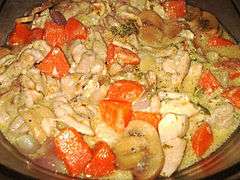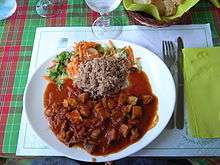Fricassee

Fricassee or fricassée /ˈfrɪkəsiː/[1] is a method of cooking meat in which it is cut up, sautéed and braised, and served with its sauce, traditionally a white sauce. Fricassee can also refer to a type of sandwich made in Tunisia with fried bread and typically filled with many ingredients including tuna, olives, hard-boiled egg, middle eastern tomato salad, and others.
Etymology
Fricassee is an old term, first attested in England in the mid-16th century. It is a French word, but the exact etymology is uncertain. It is theorized to be a compound of the French frire (to fry) and casser or quasser (to break in pieces).[2]
Description and history
Many cooking references describe fricassee simply as a French stew, usually with a white sauce.[3] Julia Child in Mastering the Art of French Cooking describes it as "halfway between a sauté and a stew" in that a saute has no liquid added, while a stew includes liquid from the beginning. In a fricassee, cut-up meat is first sauteed (but not browned), then liquid is added and it is simmered to finish cooking.[4] Cookbook author James Peterson notes that some modernized versions of the recipe call for the meat to be thoroughly browned before braising, but the classical version requires that both meat and vegetables remain white, with no caramelization.[5]

By the general description of frying and then braising in liquid, there are recipes for fricassee as far back as the earliest version of the medieval French cookbook Le Viandier, circa 1300. In 1490, it is first referred to specifically as "friquassee" in the print edition of Le Viandier.[6]
Fricassee of chicken is commonly found, both in modern recipes and antique ones, but virtually all kinds of meat, poultry, fish, and even vegetables alone, can be found in fricassee dishes.
Chicken fricassee was one of Abraham Lincoln's favorite dishes.[7]
In the Spanish Caribbean, one of the more popular dishes is Pollo en Fricasé (Chicken Fricassee). It was brought to the islands by settlers from the south of France and Spain. Unlike a typical French fricassee, it has a tomato-based sauce usually with red wine.[8]
See also
- List of meat dishes
- Lopado
temacho selacho galeo kranio leipsano drim hypo trimmato silphio parao melito katakechy meno kichl epi kossypho phatto perister alektryon opte kephallio kigklo peleio lagoio siraio baphe tragano ptery gon
References
- ↑ "Audio pronunciation of 'fricassee'". Merriam Webster. Retrieved 10 September 2013.
- ↑ "fricassee". Online Etymology Dictionary. Retrieved 8 October 2012.
- ↑ "Fricassée". CooksInfo.com. 23 September 2010. Retrieved 7 October 2012.
- ↑ Child, Julia; Beck, Simone; Bertholle, Louisette (1969). Mastering the Art of French Cooking. Alfred A. Knopf.
- ↑ Peterson, James (2008). Sauces: Classical and Contemporary Sauce Making (3 ed.). Wiley. ISBN 978-0-470-19496-6.
- ↑ Hess, Karen (1996). Martha Washington's Booke of Cookery. Columbia University Press. p. 41. ISBN 978-0-23104-931-3.
- ↑ Rysavy, Francois (1972). A Treasury of White House Cooking. New York: Putnam. p. 250. ISBN 978-0-39910-939-3.
- ↑ "pollofricase". El Boricua. Retrieved 4 October 2016.
External links
| Wikimedia Commons has media related to Fricassée. |
| Look up fricassee in Wiktionary, the free dictionary. |